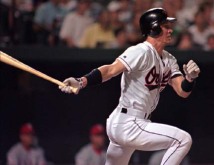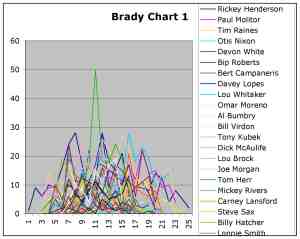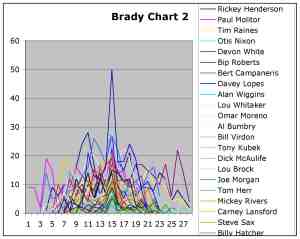 Eventually I’ll do more than suggest certain players have, oh, peculiar statistical phenomena associated with their numbers. In fact, that day is today because I’m not even going to do any statistical analysis with former Baltimore Oriole Brady Anderson.
Eventually I’ll do more than suggest certain players have, oh, peculiar statistical phenomena associated with their numbers. In fact, that day is today because I’m not even going to do any statistical analysis with former Baltimore Oriole Brady Anderson.
Later I will, but not today. Today, it’s just raw data. This was suggested in the comments to the Bonds post below. The commenter singled out Brett Boone, but I prefer showing the following numbers with Brady Anderson. No reason.
Anderson went from Boston to Baltimore in 1988. He stayed in “The Greatest City in America” (their motto, not mine) until 2001 before an unremarkable 34-game farewell campaign with the Tribe (the baseball team, not the Jews) the following year.
He also hit 50 home runs as a leadoff man in 1996. This after averaging just a shade over 15 home runs for the previous 4 seasons. Nothing strange about that. In fact, it doesn’t look the least bit strange when compared with the power numbers of other leadoff hitters.
This is Anderson and 35 other leadoff hitters. Anderson was a leadoff hitter the season he developed an uncanny ability to go yard, so that’s who he is getting compared to. A) Some readers seem to get lost on this point when I tried to construct a data set to compare Bonds to, so think about this before shouting objections and B) Responses to your anticipated objections are at the bottom of the post.
So here are two graphs of Anderson’s home run totals (vertical axis) plotted on the same graph with the other 35 players (Anderson is the green line). Again, this is just raw data. 
The x-axis is just for player years, and it’s 25 years long as to accomodate Rickey Henderson. The data was just lined up so that the middle of every player’s career sat in the middle of the graph (Year 13).
This is the exaxt same data, only it has been realigned so that every player’s peak home run season has the same x-coordinate value (Anderson is the bluish-purple line). If a player hit the same peak number in more than one season, the season later in his career was chosen to be fixed at the center. In other words, Rickey Henderson hit 28 homers in both 1986 and 1990. So Rickey Henderson’s total of 28 home runs by Rickey Henderson in 1990 was used to center Rickey Henderson’s graph about the midpoint for Rickey Henderson.
That probably didn’t help explain anything, but Rickey Henderson defies your attempts to explain him.
Anyway, that’s Anderson in both graphs, sticking out like a mormon at Ozzfest. He’s at 50HR; the next best are Davey Lopes and, again, Rickey Henderson with 28. It’s not just that Anderson hit 50, it’s a little peculiar how far he shot above the previous season’s 16, before falling back to 18 the following year.
The next most interesting player? It’s actually Lonnie Smith. No, really. After 11 years in the bigs he had never hit more than 8 HRs, until 1989 when he suddenly exploded for 21. Yes, exploded is relative, but that’s still a noticable jump. And he never hit double-digit home runs again for the remainder of his career.
Again, this is just raw data. Frankly, I have’t yet figured out the best way to show what the average increases would be over time, so that there is a good curve for comparison to Anderson or anyone else who had a ridiculous spike in power numbers (Boone, maybe Luis Gonzalez, etc.) Different career spans, number of games played, etc., kind of throw a few wrenches in the mix.
As for objections… the only one I can think of is that, by comparing Anderson to lead off guys like Dan Gladden, Carney Lansford, and Mickey Rivers, the deck is stacked against him. Anderson was a guy who hit for power and should be looked at next to other power guys.
Well, no he wasn’t. Not for the first nine years of his career he wasn’t. For that span, his power numbers look at lot like many of the other guys in the data pool. It wasn’t until he spiked to 50 that he would have been thought of as a power hitter.
Anderson couldn’t keep it up either, averaging just under 20 HRs for the following four seasons.
[Ed. Note: Thanks to the Ladies… for the love. Would like to point out that there has been rampant speculation about, oh, which side of the plate Brady Anderson bats from. Not that doesn’t mean you can’t ogle. I can gawk with full slack jaw at hot lesbians. And I am so not a double standard kind of guy. Just, you know, full disclosure (him, not me).]

November 28, 2007 at 9:24 pm
I know for a fact that hes definitely straight bc i slept with him. so yeah no need to speculate ive never met a straighter man in my life, believe me.
January 8, 2008 at 9:13 pm
What’s wrong with being gay, anonymous? And he could be bi…sleeping with women doesn’t prove that he didn’t sleep with guys also
January 8, 2008 at 9:14 pm
How about we plot Brady Anderson against Roger Maris…
Roger Maris, another big fluke…